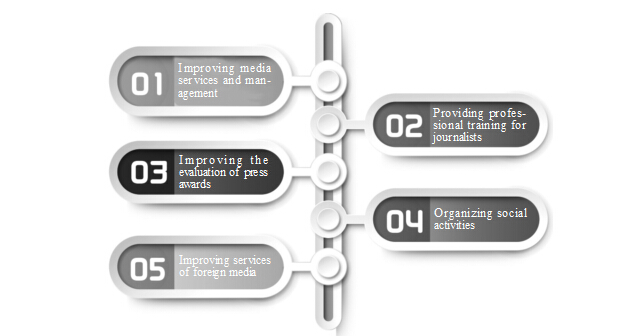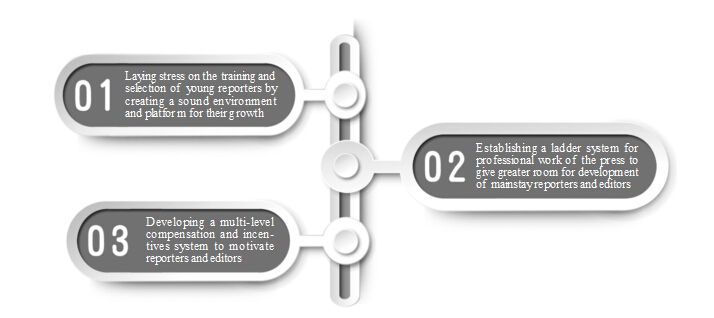|
中国记协发布《中国新闻事业发展报告(2015)》英文版
|
|
| 2016年04月29日 08:11:24 来源: 中国记协网 | |
|
|
|
|
In 2015, steady progress was made in China’s media industry amidst reform and innovation. That year, the departments concerned and various media organizations managed to create a sounder environment for the development of the media and media workers by taking a variety of steps and forms. As a result, profound changes took place in the structure of the media industry, and proactive efforts were made, under great pressure from the market, to explore integrated development of traditional and new media in terms of content, channel, platform, operation and management. Improvement was also witnessed in professional ethics of the media circles: work was done throughout the country in promoting the code of conduct by the Press Ethics Committee; the ACJA Press Ethics Committee was established, and steady progress was made in trying out reporting on the performance of their social responsibility on the part of media organizations. The Press Environment China practices a press public management system in light of its national conditions. The publicity department of the Communist Party of China (CPC), governmental institutions and press organizations have taken a variety of measures to improve services and management and regulate the order of the press work, so as to foster better environment and conditions for the development of the media industry and journalists.
1. Improving media services and management. China strives to improve its news media services and management, to ensure its long-term progress and cater to the country’s actual needs. First, streamlining administrative examination and approval. At the end of 2015, a list of 52 items was issued for administrative examination and approval, including the establishment of publishing units and examination of homemade TV dramas and films. Nine items were removed. Second, improving transparency of the press. The state issued “Measures on Government Information Disclosure in the Press,” stipulating that 10 types of information must be disclosed to the public; and the citizens, legal persons and other organizations can apply for relevant information in accordance with the law. Third, strengthening institutional building. On November 6, 2015, the SAPPRFT and the State Internet Information Office held a ceremony to present certificates to 594 journalists — the first to receive the certificate — from 14 news portals under the central government. 2. Providing professional training for journalists. China’s 300,000 news reporters and editors received training and sat in related examinations organized by the SAPPRFT for the new journalist certificates. Press units under the central government and in different provinces, autonomous regions and municipalities directly under the central government held related training sessions by varied levels and in different genres, and sound training systems have been established at most press units. Efforts have been intensified in holding professional training courses to improve the press workers’ professional skills. In 2013-14, People’s Daily organized 23 training sessions in 19 categories for 5,375 persons; in 2014 Xinhua News Agency held 176 training sessions for 13,162 of its employees; and in 2015 China Central Television (CCTV) had 273 training sessions for 14,275 of its employees. The ACJA trained 293 teachers to add to the training staff at press units at all levels. Such training has laid a solid theoretical foundation for Chinese press workers to comprehensively and accurately master basic Marxist views of journalism to enhance the level of press report. 3. Improving the evaluation of press awards. China Journalism Awards and Changjiang-Taofen Awards are China’s highest awards for news works and press workers. In 2014, an evaluation and appraisal committee was first established to audit and check the nominees and their works, disqualifying 149 works submitted for competition; to open up the channels for self-nominated works and works nominated by others, selecting and receiving 201 news works either submitted by the authors themselves or nominated by others, which accounted for one fifth of the submissions; and ruling that media organizations showing serious problems in fulfilling their responsibility for the public and reporters and editors with a record of poor ethics shall be disqualified from nomination. 4. Organizing social activities. At the end of 2014, a large-scale themed activity known by the name “China in Motion, Beautiful Stories,” was held to encourage reporters to go deep into the grassroots for firsthand experience of life to tell well China’s stories. A similar activity known by the name “Good Journalists Telling Good Stories” was held and it involved 12,000 journalists from around the country, who told moving stories about their interviews and daily work in addition to their new inspirations thus gained. Ultimately, the speeches by 10 best speakers were recorded into a special program and aired on CCTV on Chinese Journalists Day (November 8), winning warm applauses from all walks of life. 5. Improving services of foreign media. In 2015, the news center for the 70th anniversary of the Chinese People’s War of Resistance Against Japanese Aggression and the World Anti-Fascist War hosted in total 4,339 journalists, of whom there were 1,596 foreign reporters from 430 media organizations of 70 countries and regions. Moreover, the news center gave six press conferences, sponsored five field trips and five cultural activities, and made arrangements for 1,000 Chinese and overseas journalists to cover the commemoration ceremony, and provided news information services and facilities to their interviews and news dispatches. During the 2014 APEC Economic Leaders’ Meeting, China set up for the first time two news centers (one at the National Convention Center and one at Yanqihu), providing services to 4,060 reporters, including 1,859 from 504 media organizations in 61 countries. Viewed from the perspective of the media, all media organizations have, in view of their own practical needs, explored for flexible and efficient talent-training and incentive mechanisms to open up more space for the development of their reporters and editors by offering the platforms to appeal and retain talent.
1. Laying stress on the training and selection of young reporters by creating a sound environment and platform for their growth. To help young reporters improve their competence and professional skills and advance their career, many of China’s media organizations have established normalized systems for the training and selection of young talents. The Xinhua News Agency has implemented and improved the system that the young employees fresh from college go and temper themselves in the branch offices of the agency to gain necessary professional experience; established the system that its reporters and editors go to the grassroots to access firsthand information; encouraged job rotation of its young editors and reports at the headquarters and domestic branches by trying out the practice of “dual secondments”; promoting throughout the agency the “system of mentors for young employees”; and promoted outstanding young professionals to senior professional and technical positions by breaking the established rule under the precondition that the appraisal for professional titles and assignment of technical jobs are separated. In 2015, CCTV launched a program known as “Training Program for Celebrities,” including the “Training Program for Young Talents” in which 300 promising young workers every two years receive systemic training so as to turn them into leaders in their areas of expertise. As of 2010, a number of media in Guangdong Province have selected a number of aspiring young reporters and editors to go and work in the province’s township, villages and urban communities to acquire experience working in the grassroots and to include their performance in their temporary posts at the grassroots as a condition of their promotion. 2. Establishing a ladder system for professional work of the press to give grater room for development of mainstay reporters and editors. Many media organizations in China adopt a category-specific hierarchy system to provide their staff with more channels and room of development. Xinhua News Agency, for example, has tried out with the establishment of the title of “Chief Journalist of Xinhua News Agency” as the highest technical position of the agency and the “chief journalists (reporters) or editors” of the various departments, units and branch offices, put in place a system of hierarchical technical positions, and worked out an incentive and distribution policy compatible with the system of hierarchical technical positions by adopting rewards standards for “chief” and all other posts. China Education Press Agency has tailor-made a salary system comprising five tiers and 18 grades in line with the requirements of modern corporate system, and, by way of performance assessment, encourage more pay for more work and better pay for more outstanding work and allow the chief commentator, editor and reporter to get equal pay with the president, so as to arouse to the full the employees’ enthusiasm and creativity. Guangzhou Daily Group has 13 professional ranks, from trainee reporter to chief reporter and chief editor. The chief reporter earns a salary close to that of the Group’s deputy editor-in-chief, and a senior reporter’s salary is similar to a middle-level manager at the Group. The performance of the employees is evaluated every two years and the result of the evaluation serves as a major criterion to decide their rankings. Sichuan Daily Group’s chief reporter and chief editor earn salaries the same as or even higher than that of the Group’s president. 3. Developing a multi-level compensation and incentives system to motivate reporters and editors. Many of China’s media have kept regularizing and adjusting their performance-based pay systems and incentives policies, establishing and improving incentives, establishing innovation project incentive mechanism to arouse the enthusiasm of reporters and editors. To appeal the high-end professionals urgently needed for their own development, some media have adopted special remuneration policies by referring to market standards, experimenting with annual salary system to retain talent and maximize productivity. At Xinhua, experts and core professionals are evaluated and managed according to their categories, and those who make outstanding contribution are rewarded with citations of merit and other awards. It also holds regular appraisals of agency-level experts, such as the Xinhua Top 10 Editors and Reporters. The CCTV has established an annual innovation fund for employees, mainly to sponsor the network’s innovation competitions and the innovation-related activities of its departments, and to reward the winners of such events. In 2014, Zhejiang Daily Group kicked off the “Star Project,” for which the Group and its listed companies injected a fund of RMB30 million for the incubation of innovative projects. A total of 17 projects were screened for incubation support from the Group. |
|
|
(责任编辑:
刘艳丹
)
|

